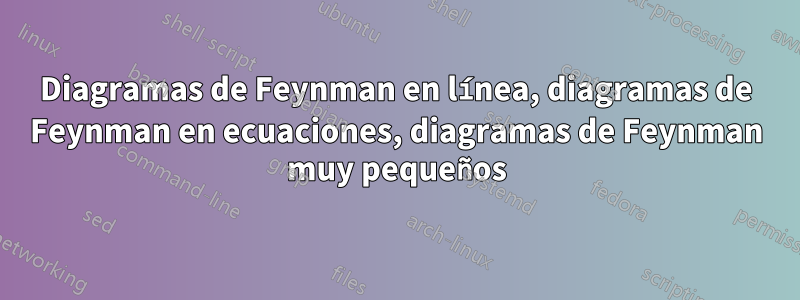
Me gustaría componer ecuaciones como:


Probé esto con la biblioteca tikz-feynman, pero los diagramas generados por ella son demasiado grandes, incluso con la opción pequeña (y también parecen incómodos). De manera óptima, quiero escribir diagramas simples incluso en línea con el texto, para evitar describir el diagrama de manera incómoda o usar mucho espacio e interrumpir el flujo del documento para mostrar el diagrama.
Respuesta1
AFAIK, no te doblan las flechas tikz-feynman. Y como parece que no necesita los algoritmos de dibujo de gráficos (y como no se pueden cargar en arXv), puede trabajar con Ti simple.kZ.
\documentclass[fleqn]{article}
\usepackage{amsmath}
\usepackage{mathrsfs}
\usepackage{tikz}
\usetikzlibrary{arrows.meta,bending,decorations.markings}
% from https://tex.stackexchange.com/a/430239/121799
\tikzset{% inspired by https://tex.stackexchange.com/a/316050/121799
arc arrow/.style args={%
to pos #1 with length #2}{
decoration={
markings,
mark=at position 0 with {\pgfextra{%
\pgfmathsetmacro{\tmpArrowTime}{#2/(\pgfdecoratedpathlength)}
\xdef\tmpArrowTime{\tmpArrowTime}}},
mark=at position {#1-\tmpArrowTime} with {\coordinate(@1);},
mark=at position {#1-2*\tmpArrowTime/3} with {\coordinate(@2);},
mark=at position {#1-\tmpArrowTime/3} with {\coordinate(@3);},
mark=at position {#1} with {\coordinate(@4);
\draw[-{Triangle[length=#2,bend]}]
(@1) .. controls (@2) and (@3) .. (@4);},
},
postaction=decorate,
},
fermion arc arrow/.style={arc arrow=to pos #1 with length 2.5mm},
Vertex/.style={fill,circle,inner sep=1.5pt},
insert vertex/.style={decoration={
markings,
mark=at position #1 with {\node[Vertex]{};},
},
postaction=decorate}
}
\DeclareMathOperator{\tr}{tr}
\begin{document}
\[\mathscr{P}(\varphi)=-\sum\limits_{n=1}^\infty\tr\left(\Delta L_{12}\right)^n
=\vcenter{\hbox{\begin{tikzpicture}
\draw[thick,insert vertex=0,fermion arc arrow={0.55}] (0,0) arc(270:-90:0.6);
\end{tikzpicture}}}+\frac{1}{2}
\vcenter{\hbox{\begin{tikzpicture}
\draw[thick,insert vertex/.list={0,0.5}](0,0) arc(270:-90:0.6);
\draw[fermion arc arrow/.list={0.3,0.8}] (0,0) arc(270:-90:0.6);
\end{tikzpicture}}}
+\frac{1}{3}
\vcenter{\hbox{\begin{tikzpicture}
\draw[thick,insert vertex/.list={0,1/3,2/3}](0,0) arc(270:-90:0.6);
\draw[fermion arc arrow/.list={0.21,0.55,0.88}] (0,0) arc(270:-90:0.6);
\end{tikzpicture}}}+\dots\;.
\]
\[
G(x_1,\dots x_n)=\sum\limits_{m=0}^\infty\frac{1}{m!}
\begin{tikzpicture}[baseline={(X.base)}]
\node[circle,draw,thick,inner sep=2pt] (X) at (0,0) {$n+m$};
\foreach \X in {60,90,120}
{\draw[thick] (\X:0.6) -- (\X:0.9) node[Vertex]{};}
\foreach \X in {-60,-80,-100,-120}
{\draw[thick] (\X:0.6) -- (\X:0.9);}
\node[rotate=-30,overlay] at (-120:1.1){$x_1$};
\node[rotate=30,overlay] at (-60:1.1){$x_n$};
\node at (-90:1.1){$\cdots$};
\end{tikzpicture}
\]
\end{document}



